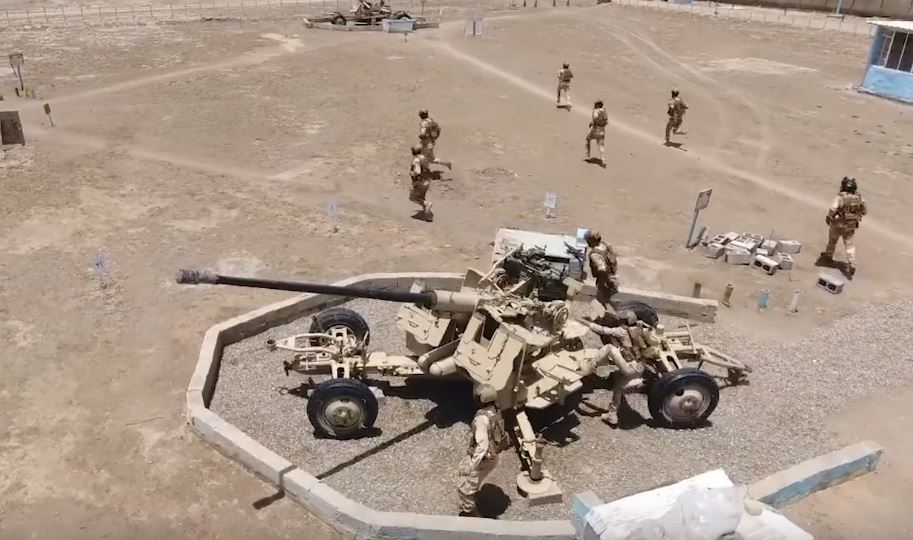Iraqi Anti-Aircraft Guns Are Back In Business

A news clip from Iraq’s defense ministry meant to show off the army’s anti-aircraft systems revealed a surprising comeback for a particular weapon. In its Baathist heyday the Iraqi armed forces boasted a separate air defense branch patterned after the Soviet model. The branch enjoyed a historic expansion in the eight years of war against Iran (the Israeli strike on Osirak was another contributing factor) and prior to Operation Desert Storm in 1991 the US-led coalition worried about several thousand surface-to-air missiles and an estimated 8,500 anti-aircraft guns used by the Iraqis. At the time, US war planners identified 1,300 anti-aircraft guns around Baghdad alone.
In fairness, the majority of these were the lightweight ZPU-2’s and ZPU-4’s that used the Soviet-made 14.5x114mm KPV heavy machine gun in either pairs or quartets. The Iraqis had also stocked up on the 23mm ZSU-23-2 and the 37mm Type 65/74 anti-aircraft guns, the latter being supplied by China in generous quantities. The heaviest among this lethal inventory were the Soviet-made S-60’s meant to knock out any aircraft at altitudes below 4,000 meters. Other Arab states that received S-60’s were regular Soviet customers Egypt and Syria.
The S-60 was a large 57mm gun on a pivoting mount carried by a four-wheel trailer. Transporting the S-60 along with its cumbersome ammunition supply could be done using any truck or tractor. Although the Soviets mass-produced the S-60 and delivered thousands to its allies and clients information about its proper usage remains incomplete. What is understood is, in a battery of six guns, each must have a full crew for operating the weapons. Iraq’s defense ministry shows its refurbished S-60’s having three crew per gun but one wonders who will feed the ammunition to the breech–at least two persons are needed for loading the clips of 57x348mm ammunition. The size and weight of the 57mm rounds meant these are loaded in clips with four rounds each. The physical exertion required during combat is understandably taxing on the crew.

Because of its age–S-60’s were manufactured in the 1950s until the early 1960s–its combat record is neglected, although it did prove itself during the Vietnam War (1965-1973), and it wasn’t until the current Syrian Civil War (2011-present) along with the global effort to defeat ISIS (2014-present) that the S-60 saw widespread use once again as an artillery piece. But the reason why S-60’s are returning to service with the Iraqi armed forces in their original role is perplexing. It turns out after defeating the Iraqis several times in the last 30 years, not to mention toppling the Baathist regime in 2003, the US military never bothered tracking the leftover equipment of their vanquished foe. Many S-60’s along with other anti-aircraft weapons were abandoned in the Kuwaiti desert but it’s now clear a lot more were left behind with the Iraqi army.
Despite the burden of fighting ISIS for several years Iraq’s defense ministry did succeed at reviving a minimum air defense capability. Rather than settle on the AN/TWQ-1 Avenger SAMs supplied by the US a batch of Russian Pantsir-S1’s were acquired. How refurbished batteries of S-60 anti-aircraft guns are supposed to complement the newer Pantsirs is confusing since tracking radars and fire control posts for the guns appear missing. It’s possible to upgrade the S-60 batteries with newer technology though but there’s little information, if any, from the Iraqis on how this will be done. A distinct advantage for using its S-60’s is to bolster short-range air defenses in critical and sensitive locations, especially against drones. The difficult lessons learned from the war against Daesh and the ongoing conflict in neighboring Saudi Arabia against the Houthis should justify the redeployment of anti-aircraft artillery to anticipate the drone threat even if jammers and lasers are ideal countermeasures against these.
Three decades ago the Iraqi armed forces had the largest arsenal of anti-aircraft systems in the Middle East. Of course, it has since been eclipsed by Iran and Israel. But at its peak, Iraq amassed the full range of Soviet-made SAMs such as the SA-2, SA-3, SA-6, SA-8, and SA-13 along with French-made Roland SAMs. A remarkable detail about this SAM collection was their integration to a computerized command and control hub in Baghdad supplied by the French called KARI. This virtual umbrella of missile defenses were reinforced by self-propelled anti-aircraft guns such as the ZSU-57-2 and the ZSU-23-4. It’s possible that large numbers of surviving self-propelled and towed anti-aircraft guns are kept in military bases as reserve stocks. These may prove useful while the defense ministry shops around for newer longer-range air defenses from a willing supplier.













Comments are closed.